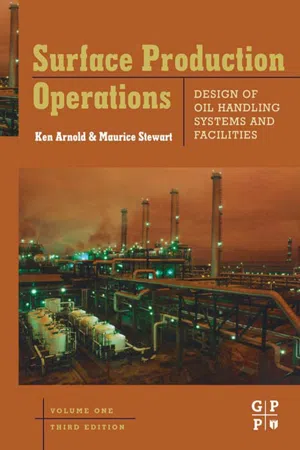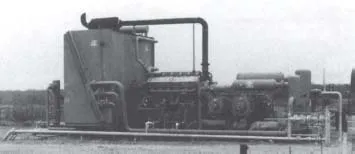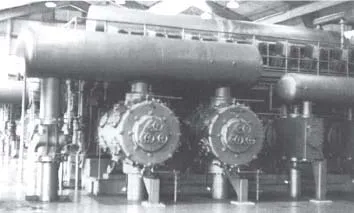
eBook - ePub
Surface Production Operations, Volume 1
Design of Oil Handling Systems and Facilities
- 768 pages
- English
- ePUB (mobile friendly)
- Available on iOS & Android
eBook - ePub
Surface Production Operations, Volume 1
Design of Oil Handling Systems and Facilities
About this book
The latest edition of this best-selling title is updated and expanded for easier use by engineers. New to this edition is a section on the fundamentals of surface production operations taking up topics from the oilfield as originally planned by the authors in the first edition. This information is necessary and endemic to production and process engineers. Now, the book offers a truly complete picture of surface production operations, from the production stage to the process stage with applications to process and production engineers.
- New in-depth coverage of hydrocarbon characteristics, the different kinds of reservoirs, and impurities in crude
- Practical suggestions help readers understand the art and science of handling produced liquids
- Numerous, easy-to-read figures, charts, tables, and photos clearly explain how to design, specify, and operate oilfield surface production facilities
Frequently asked questions
Yes, you can cancel anytime from the Subscription tab in your account settings on the Perlego website. Your subscription will stay active until the end of your current billing period. Learn how to cancel your subscription.
No, books cannot be downloaded as external files, such as PDFs, for use outside of Perlego. However, you can download books within the Perlego app for offline reading on mobile or tablet. Learn more here.
Perlego offers two plans: Essential and Complete
- Essential is ideal for learners and professionals who enjoy exploring a wide range of subjects. Access the Essential Library with 800,000+ trusted titles and best-sellers across business, personal growth, and the humanities. Includes unlimited reading time and Standard Read Aloud voice.
- Complete: Perfect for advanced learners and researchers needing full, unrestricted access. Unlock 1.4M+ books across hundreds of subjects, including academic and specialized titles. The Complete Plan also includes advanced features like Premium Read Aloud and Research Assistant.
We are an online textbook subscription service, where you can get access to an entire online library for less than the price of a single book per month. With over 1 million books across 1000+ topics, we’ve got you covered! Learn more here.
Look out for the read-aloud symbol on your next book to see if you can listen to it. The read-aloud tool reads text aloud for you, highlighting the text as it is being read. You can pause it, speed it up and slow it down. Learn more here.
Yes! You can use the Perlego app on both iOS or Android devices to read anytime, anywhere — even offline. Perfect for commutes or when you’re on the go.
Please note we cannot support devices running on iOS 13 and Android 7 or earlier. Learn more about using the app.
Please note we cannot support devices running on iOS 13 and Android 7 or earlier. Learn more about using the app.
Yes, you can access Surface Production Operations, Volume 1 by Maurice Stewart,Ken E. Arnold in PDF and/or ePUB format, as well as other popular books in Technology & Engineering & Chemical & Biochemical Engineering. We have over one million books available in our catalogue for you to explore.
Information
Edition
3Chapter 1 The Production Facility
Introduction
The job of a production facility is to separate the well stream into three components, typically called “phases” (oil, gas, and water), and process these phases into some marketable product(s) or dispose of them in an environmentally acceptable manner. In mechanical devices called “separators,” gas is flashed from the liquids and “free water” is separated from the oil. These steps remove enough light hydrocarbons to produce a stable crude oil with the volatility (vapor pressure) to meet sales criteria. Figures 1-1 and 1-2 show typical separators used to separate gas from liquid or water from oil. Separators can be either horizontal or vertical in configuration. The gas that is separated must be compressed and treated for sales. Compression is typically done by engine-driven reciprocating compressors (see Figure 1-3). In large facilities or in booster service, turbine-driven centrifugal compressors, such as that shown in Figure 1-4, are used. Large integral reciprocating compressors are also used (see Figure 1-5).

Figure 1-1. A typical vertical two phase separator at a land location. The inlet comes in the left side, gas comes off the top, and liquid leaves the bottom right side of the separator.

Figure 1-2. A typical horizontal separator on an offshore platform showing the inlet side. Note the drain valves at various points along the bottom and the access platform along the top.

Figure 1-3. Engine-driven reciprocating compressor package. The inlet and inter-stage scrubbers (separators) are at the right. The gas is routed through pulsation bottles to gas cylinders and then to the cooler on the left end of the package. The engine that drives the compressor cylinders is located to the right of the box-like cooler.

Figure 1-4. Turbine-driven centrifugal compressor package. The turbine draws air in from the large duct on the left. This is mixed with fuel and ignited. The jet of gas thus created causes the turbine blades to turn at high speed before being exhausted vertically upward through the large cylindrical duct. The turbine shaft drives the two centrifugal compressors, which are located behind the control cabinets on the tight end of the skid.

Figure 1-5. A 5500-Bhp integral reciprocating compressor. The sixteen power cylinders located at the top of the unit (eight on each side) drive a crankshaft that is directly coupled to the horizontal compressor cylinders facing the camera. Large cylindrical “bottles” mounted above and below the compressor cylinders filter out acoustical pulsations in the gas being compressed.
Usually, the separated gas is saturated with water vapor and must be dehydrated to an acceptable level, normally less than 7 lb/MMscf (110 mg H2O/Sm3). This is normally done in a glycol dehydrator, such as that shown in Figure 1-6.

Figure 1-6. A small glycol gas dehydration system. The large vertical vessel on the left is the contact tower where “dry” glycol contacts the gas and absorbs water vapor. The upper horizontal vessel is the “reboiler” or “reconcentrator” where the wet glycol is heated, boiling off the water that exits the vertical pipe coming off the top just behind the contact tower. The lower horizontal vessel serves as a surge tank.
Dry glycol is pumped to the large vertical contact tower, where it strips the gas of its water vapor. The wet glycol then flows through a separator to the large horizontal reboiler, where it is heated and the water boiled off as steam.
In some locations it may be necessary to remove the heavier hydrocarbons to lower the hydrocarbon dew point. Contaminants such as H2S and CO2 may be present at levels higher than those acceptable to the gas purchaser. If this is the case, then additional equipment will be necessary to “sweeten” the gas.
The oil and emulsion from the separators must be treated to remove water. Most oil contracts specify a maximum perce...
Table of contents
- Cover
- Title Page
- Copyright
- Acknowledgments to the Third Edition
- About the Book
- Preface to the Third Edition
- Table of Contents
- Chapter 1: The Production Facility
- Chapter 2: Process Selection
- Chapter 3: Basic Principles
- Chapter 4: Two-Phase Oil and Gas Separation
- Chapter 5: Three-Phase Oil and Water Separation
- Chapter 6: Mechanical Design of Pressure Vessels
- Chapter 7: Crude Oil Treating and Oil Desalting Systems
- Chapter 8: Crude Stabilization
- Chapter 9: Produced Water Treating Systems
- Chapter 10: Water Injection Systems
- Appendix A: Definition of Key Water Treating Terms
- Appendix B: Water Sampling Techniques
- Appendix C: Oil Concentration Analysis Techniques
- Glossary of Terms
- Index